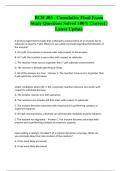BCH 403 - Cumulative Final Exam
Study Questions Solved 100% Correct |
Latest Update
A kinetics experiment reveals that a Michaelis constant (Km) of an enzyme for its
substrate is equal to 7 μM. What can you safely conclude regarding the behavior of
the enzyme?
A. At 5 μM, the reaction is second order with respect to the enzyme.
B. At 7 μM, the reaction is zero order with respect to substrate.
C. The reaction Vmax occurs at greater than 7 μM substrate concentration.
D. The reaction is already operating at Vmax.
E. All of the answers are true. - Answer C. The reaction Vmax occurs at greater than
7 μM substrate concentration.
Under conditions where [S] >> Km, enzymatic reactions become zero order with
respect to substrate because:
A. The enzyme reaches one-half saturation.
B. The reactions are actually still first order with respect to substrate.
C. The enzyme becomes saturated with enzyme and is performing catalysis at
maximum capacity.
D. At high concentrations, substrate can allosterically modulate enzyme catalysis.
E. The enzyme has degraded. - Answer C. The enzyme becomes saturated with
enzyme and is performing catalysis at maximum capacity.
Upon adding a catalyst, the ΔΔG°‡ of a reaction becomes very large. What can
you conclude about the rate constant of the reaction?
A. It has most likely increased.
B. It has most likely decreased.
,C. I cannot make any conclusions about the rate constant with this information.
D. It is definitely a first order rate constant.
E. The catalyst is not very efficient. - Answer A. It has most likely increased.
T/F: The thermodynamics of a biochemical reaction can be driven by either favorable
changes in enthalpy or favorable changes in entropy, but not by both. - Answer False
T/F: Hydrogen bonds are weak electrostatic interactions that are made possible by
the presence of partial charges on H-bond donors and acceptors. - Answer True
T/F: Carbonic acid has a pKa of 6.37; acetic acid has a pKa of 4.76; therefore,
carbonic acid is the stronger acid. - Answer False
T/F: Small proteins elute earliest in a gel filtration column, but travel fastest on SDS-
PAGE. - Answer False
T/F: Peptide bonds are planar due to the partial double bond character of
neighboring R-groups. - Answer False
T/F: Formation of a new peptide bond produces one molecule of water and
one hydroxide ion. - Answer False
T/F: Protein folding is made energetically favorable because of the combined
contributions of the hydrophobic effect, van der Waals interactions, hydrogen-bonding,
salt bridge interactions, and disulfide bonds. - Answer True
T/F: In protein folding, the hydrophobic effect and van der Waals interactions contribute
favorably to the entropy component of the Gibbs free energy equation. - Answer False
T/F: Alpha-keratins have a pseudo-repeat motif of (abcdef)g, in which a and d
are negatively charged residues. - Answer False
,T/F: The sigmoidal oxygen-binding curve of hemoglobin is an indicator of
cooperativity between the hemoglobin subunits. - Answer True
Upon running SDS-PAGE on a protein complex that consists of 5 subunits, of which 3
subunits are the same size and two have distinct sizes (different from each other and
different from the other three), how many bands should you expect to see on the gel?
A. one band
B. two bands
C. three bands
D. five bands - Answer C. three bands
A reaction with a ΔG equal to zero can best be described as:
A. A system where the reactants and products are equal.
B. A system that has reached an equilibrium.
C. A system that requires ATP as a thermodynamic coupler in order to reach equilibrium.
D. A system where the change in entropy is the principle driving force.
E. A system where the change in enthalpy is the principle driving force. - Answer B. A
system that has reached an equilibrium.
Use the chart to answer this question. Which of the following sets of residues
would most likely be found on a protein surface?
A. glycine, arginine, histidine, glutamate
B. glycine, proline, phenylalanine, isoleucine
C. valine, alanine, tyrosine, glutamate
D. serine, cysteine, leucine, valine - Answer A. glycine, arginine, histidine, glutamate
, The polypeptide shown below needs to be separated from other polypeptides of similar
size (at pH 7.0). What purification technique is best suited to isolate this peptide?
A. Nickel affinity chromatography, since it contains a histidine residue that can
bind metal.
B. Size exclusion chromatography, since the polypeptide has some
hydrophobic residues.
C. Anion exchange chromatography, since the polypeptide has a net positive charge.
D. Anion exchange chromatography, since the polypeptide has a net negative charge. -
Answer D. Anion exchange chromatography, since the polypeptide has a net negative
charge.
The helical wheel projection represents a 14-residue α-helix that is part of a
larger protein structure. Which of the following would apply?
A. The α-helix is amphipathic with respect to hydrophobicity and therefore will
be partially buried in the protein structure.
B. The α-helix is not amphipathic at all.
C. At neutral pH, the α-helix is amphipathic with respect to charge.
D. At basic pH, the α-helix would be entirely buried in the hydrophobic core of the
structure. - Answer C. At neutral pH, the α-helix is amphipathic with respect to charge.
The small side chain of glycine allows it to do which of the following?
A. Fit into the small space at the center of β-turns.
B. Destabilize β-turns.
C. Fit into the small space between the interwound strands of fibroin.
D. Fit in between the closely packed β-sheets of α-keratin.




